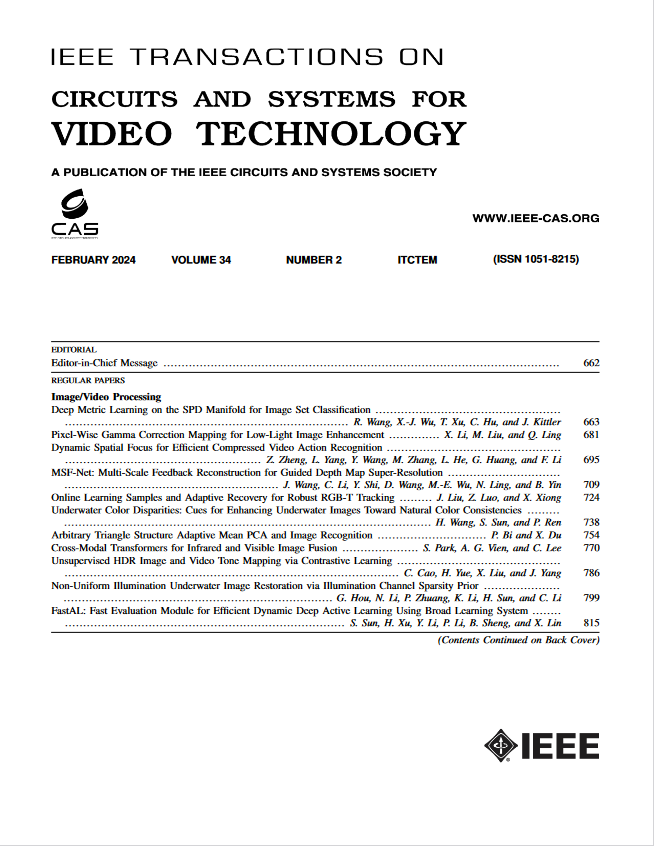Future Feature-Based Supervised Contrastive Learning for Streaming Perception
IF 8.3
1区 工程技术
Q1 ENGINEERING, ELECTRICAL & ELECTRONIC
IEEE Transactions on Circuits and Systems for Video Technology
Pub Date : 2024-08-07
DOI:10.1109/TCSVT.2024.3439692
引用次数: 0
Abstract
Streaming perception, a critical task in computer vision, involves the real-time prediction of object locations within video sequences based on prior frames. While current methods like StreamYOLO mainly rely on coordinate information, they often fall short of delivering precise predictions due to feature misalignment between input data and supervisory labels. In this paper, a novel method, Future Feature-based Supervised Contrastive Learning (FFSCL), is introduced to address this challenge by incorporating appearance features from future frames and leveraging supervised contrastive learning techniques. FFSCL establishes a robust correspondence between the appearance of an object in current and past frames and its location in the subsequent frame. This integrated method significantly improves the accuracy of object position prediction in streaming perception tasks. In addition, the FFSCL method includes a sample pair construction module (SPC) for the efficient creation of positive and negative samples based on future frame labels and a feature consistency loss (FCL) to enhance the effectiveness of supervised contrastive learning by linking appearance features from future frames with those from past frames. The efficacy of FFSCL is demonstrated through extensive experiments on two large-scale benchmark datasets, where FFSCL consistently outperforms state-of-the-art methods in streaming perception tasks. This study represents a significant advancement in the incorporation of supervised contrastive learning techniques and future frame information into the realm of streaming perception, paving the way for more accurate and efficient object prediction within video streams.未来基于特征的流媒体感知监督对比学习
流感知是计算机视觉中的一项关键任务,它涉及到基于先前帧的视频序列中物体位置的实时预测。虽然像StreamYOLO这样的当前方法主要依赖于坐标信息,但由于输入数据和监督标签之间的特征不一致,它们往往无法提供精确的预测。本文介绍了一种新的方法,基于未来特征的监督对比学习(FFSCL),通过结合来自未来框架的外观特征和利用监督对比学习技术来解决这一挑战。FFSCL在当前和过去帧中的对象外观及其在后续帧中的位置之间建立了强大的对应关系。该方法显著提高了流感知任务中目标位置预测的精度。此外,FFSCL方法还包括一个样本对构建模块(SPC),用于基于未来帧标签有效地创建正样本和负样本,以及一个特征一致性损失模块(FCL),通过将未来帧的外观特征与过去帧的外观特征联系起来,提高监督对比学习的有效性。FFSCL的有效性通过两个大规模基准数据集的广泛实验得到了证明,其中FFSCL在流感知任务中始终优于最先进的方法。这项研究代表了将监督对比学习技术和未来框架信息结合到流感知领域的重大进步,为视频流中更准确、更有效的对象预测铺平了道路。
本文章由计算机程序翻译,如有差异,请以英文原文为准。
求助全文
约1分钟内获得全文
求助全文
来源期刊
CiteScore
13.80
自引率
27.40%
发文量
660
审稿时长
5 months
期刊介绍:
The IEEE Transactions on Circuits and Systems for Video Technology (TCSVT) is dedicated to covering all aspects of video technologies from a circuits and systems perspective. We encourage submissions of general, theoretical, and application-oriented papers related to image and video acquisition, representation, presentation, and display. Additionally, we welcome contributions in areas such as processing, filtering, and transforms; analysis and synthesis; learning and understanding; compression, transmission, communication, and networking; as well as storage, retrieval, indexing, and search. Furthermore, papers focusing on hardware and software design and implementation are highly valued. Join us in advancing the field of video technology through innovative research and insights.

 求助内容:
求助内容: 应助结果提醒方式:
应助结果提醒方式:


